USS Boston (CAG-1) Construction: Hull
Click on any image to view larger version. Use browser's BACK function to return.
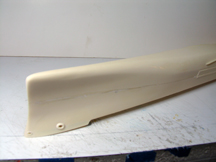
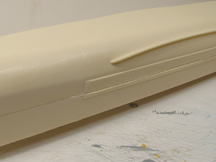
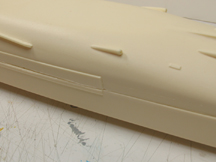
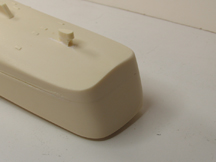
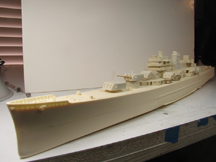
|
|
As mentioned elsewhere, I was forced to request a replacement hull from the manufacturer
due to some significant quality issues with the original parts. The replacement was much better
in terms of general quality (in fact I think one of YMW's strong-suits was the quality of their
hulls).
As I had decided to build Boston full-hull, I first turned to the task of truing-up the
top and bottom halves using files and sandpaper taped to my workbench. After the mating surfaces
were perfectly flat I clamped the halves together in their "best-fit" position as shown in the
mock-up at left. I then drilled three holes along the centerline from the top half into the bottom,
and fit three 0.040" brass dowels. If you aren't already aware of this technique, it allows for
disassembly of the hull halves, application of glue, and reassembly with a guaranteed alignment on
the first try. Very important when working with cyanoacrylates!
|
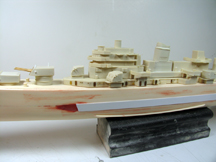
|
|
Once the hull halves were joined, I continued with the process of truing up the bow and stern,
then moving along the seam. I am a fan of spot putty, which is very fine and sands almost too
easily. I soon discovered that the armor plate running along the waterline
was too thin (according to published sources), so I removed the cast-in detail from each side
and replaced them strips of styrene cut to shape.
with
|
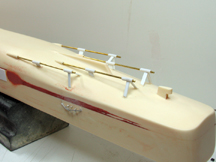
|
|
Next I turned my attention to the shaft logs and struts. The kit-supplied white-metal struts
were horrible: poorly cast and not well-shaped. I made new struts using styrene tubing and strip
stock. I shaped and attached the rudder using a brass post such that the rudder remains positionable:
I find that doing so reduces the risk of breaking the rudder off during inevitable handling downstream.
I attempted to use the kit-supplied prop guards, but again the white-metal parts were just not
up to the level of quality I was after. I removed the parts and left the task of building some
from scratch for (much, as it turned out) later.
|
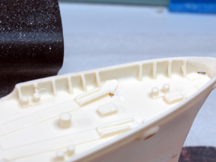
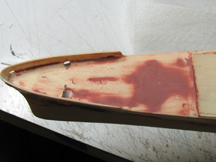
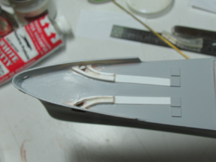
|
|
Next up, I turned to the foc'sle. Initial inspection revealed the following problems:
- the framework was too thick, and there were an insufficient number
- the hawsepipes were crude and poorly cast
- the windlass stands were out of scale (too thick)
- various hatches were incorrectly positioned for the year configuration I was after
- other, more-minor issues.
As a result, I photographed and measured the kit foc'sle, then scraped everything off save for the
hull plating which extends above the maindeck at the very bow. I drilled out the hawsepipes, then created
new deck flanges and chain guides from strip styrene. These parts were actually fairly challenging as
they follow a "natural" curve which had to be carved into the plastic. New frames were added, as
were windlass stands, hatches, and other deck equipment.
|
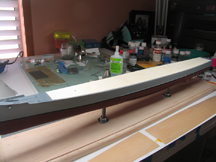
|
|
Since I had planned on using a real-wood maindeck, I sanded the cast-in planking detail down until I
had a nice smooth surface. On my kit, the edge of the wood planking where it meets the sides of the hull
was full of air bubbles: I spent a good deal of time with putty and sanding stick correcting this problem.
At this point, I made a "construction stand" consisting of unfinished hickory. I attached the hull using two
pieces of 1/4"-20 threaded rod inserted into holes drilled and tapped into the bottom of the hull. In this manner
I was able to adjust the height of the hull at bow and stern until satisfied with the level: this in turn
allowed for very easy marking of the waterline. I primed the finished hull, corrected remaining issues,
then coated the upper works and hull sides followed by the bottom. Finally I applied a black bootstripe.
|
| |
I left much of the transom as-is.
|
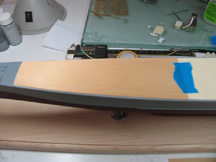
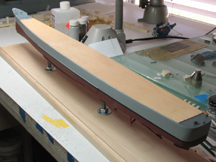
|
|
The deck piece I used (which was not die-cut for Boston) required that I have a seam. After studying the
layout of the superstructure, I found that if I located this seam beneath the forward five-inch mounts it would
be nearly invisible. I carefully made a template of the maindeck by attaching a piece of paper to the hull, then
"scrubbing" a pencil over the deck edge - much like many of us used to do when copying a quarter as a kid. I
cut the template out, check fit to the deck, then transferred the shape to the wood deck I had purchased from
ScaleDecks.com. This is one of those operations where you must keep in mind that top and bottom sides DO matter
(else you may find yourself doing the whole operation over... hint hint).
Jim at ScaleDecks recommended that I use a good deal of cyanoacrylate to attach the deck, so I used masking
tape to form a hinge at the seam, coated the bottom of the deck with superglue, then folded it over at the hinge,
allowing for perfect alignment on the first try. I repeated the process for the aft piece of deck, and much to
my surprise, both operations turned out very well.
A note about the deck material I used. I found ScaleDecks.com to provide outstanding product with great
customer service. The wood material is very nice, with in-scale planking subtly scribed in. There are no
butt joints present, which I happen to prefer. You cannot see these joints when viewing a prototype from any
real distance, and I think they make the deck of a scale model far too busy. Just my opinion...
At this point I set the hull aside and moved on to the superstructure.
|
|